Seoul Grand Park
Seoul Grand Park (Korean: 서울대공원) or Gwacheon Seoul Grand Park (과천서울대공원) is a park complex to the south of Seoul, South Korea, in the city of Gwacheon.[1] Opened on May 1 in 1984.[1]
| Seoul Grand Park | |
|---|---|
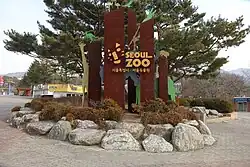 Seoul Grand Park Zoo, 2015 | |
| Location | Makgye-dong, Gwacheon, South Korea |
| Coordinates | 37°25′50″N 127°01′02″E |
| Established | 1984 |
| Website | grandpark |
| Korean name | |
| Hangul | |
| Hanja | |
| Revised Romanization | Seoul Dae Gongwon |
| McCune–Reischauer | Sŏul Dae Kongwŏn |
| Gwacheon Seoul Grand Park | |
| Hangul | 과천서울대공원 |
| Hanja | 果川서울大公園 |
| Revised Romanization | Gwacheon Seoul Daegongwon |
| McCune–Reischauer | Kwach'ŏn Sŏul Taegongwŏn |
Facilities at Seoul Grand Park include hills and hiking trails, Seoul Grand Park Zoo, Children's Zoo, a rose garden, Seoul Land amusement park, and the Seoul Museum of Modern Art.[2]
The attractions all have separate admission fees. Line 4 of the Seoul Metropolitan Subway stops at Seoul Grand Park Station.[3] A shuttle bus from the station visits the art museum and upper park entrance.
Facilities
Seoul Zoological Garden
Seoul Zoological Garden or Seoul Grand Park Zoo or Seoul Zoo[4] (서울동물원; 서울動物園) is first zoo in the Korean[1] peninsula.
The Seoul Zoo has more than 3,000 animals from 330 species. The zoo is the 10th largest in the world and a recognized member of the Species360 (formerly International Species Information System or ISIS) and the World Zoo Organization.[5]
History

The Seoul Zoo was created in November 1, 1909 by the Japanese, in the former royal palace of Changgyeonggung, which was under the changed name of Changgyeongwon (창경원; 昌慶苑) or Changgyeong Park, the "gung" standing for the Korean word 'palace', and the "won" standing for the Korean word 'park'.[1] The zoo opened in November 1909 with Siberian tigers, kangaroos, ostriches, camels, orangutans, and other animals.[6] The Japanese also built a botanical garden, and museum on the site.[7]
Towards the end of World War II the Japanese gave orders to kill the animals in the zoo, poisoning 150 animals.[8] Animals that survived this had to also survive the end of the war, when all the remaining zookeepers fled the zoo.[6]
After independence in 1945 and the turmoil and destruction of the 1950–53 Korean War, the zoo was restocked through donations of wealthy Koreans as well as gifts from foreign zoos.[9] The zoo was maintained by the South Korean government at Changgyeongwon until 1984 when it was relocated to its current site in Makgyedong, Gwacheon.[2]
On July 27, 1987, due to the heavy rain that occurred at the time, a landslide occurred around 5:00 am in the area of the Carnivore Enclosure section where 21 animals of 7 species were housed. This complete destruction, the tiger cage's isolation fence was destroyed in half, and two coyotes escaped, captured and reaccommodated. Assuming that the jaguars housed in the zoo died after being buried in the soil, the Seoul Zoo find the corpse, but it was not found. A 10-year-old female jaguar escaped. It was confirmed that she had run away, and the search started at 12:00 on the same day, and at around 18:30 on July 28, 37 hours after the incident occurred, at 245m above sea level in Mt. Cheonggyesan, it ended with being killed.[10][11]
On the morning of December 6, 2010, while the Seoul Zoo moved Kkoma (꼬마; lit. kid)[12] who is a male Malayan sun bear to the quarantine area and cleaned the release area, he opened the door with his front paws[13] and escaped to Mt. Cheonggyesan. Since the Malayan sun bear is small enough to be captured, the zoo was planned to capture Kkoma alive rather than kill.[14] The tracking continued for about 9 days, but it was difficult to directly capture Kkoma, and a trap operation was conducted to catch him by decoy rather than tracking to reduce the stress caused by excessive tracking. On December 13, 2010, Kkoma ate snacks, cup noodles, Yōkan, etc. and drank juices and a Makgeolli at the food stalls on the mountain.[15] Then, two days later, on December 15, the 9th day[16] of the escape, Kkoma was caught in the trap[17] that had been set up, after that, he was shot with a tranquilizer gun to calm down and move inside the trap, and returned safely to the zoo.[18]
On August 5, 2012, a male white rhinoceros, Kodol, escaped from the inner room and went into the zookeeper's kitchen and tool storage room, but was injured by bumping into the body in a small space. Water guns were fired to send them away, but Kodol died of heart attack.[19]
In Pacific Land Aquarium, Jungmun Tourist Complex, Seogwipo-si city, Jeju Special Self-Governing Province, Indo-Pacific bottlenose dolphins caught in fishing nets were originally supposed to be released, but they were illegally purchased from fishermen and mobilized for dolphin shows.[20] Meanwhile, Seoul Grand Park brought in illegally caught dolphins in 1999, 2002, and 2009 by purchasing or exchanging Geumdeung, Daepo, and Jedol (제돌) (or Jedoli (제돌이)), respectively. On March 2, 2013, after the illegal capture became known, environmental groups called for the dolphins to be released. On March 12, 2013, the city of Seoul decided to release Jedol, who was young and had just been bred, after hearing the opinions of experts. The decision to confiscate the dolphins was made through the criminal trial against Pacific Land Aquarium, and this judgment was upheld in the first and second trials and confirmed by the Supreme Court on March 28, 2013. On April 8, dolphins was confiscated. The confiscated dolphins were four: Chunsam, D-38, Taesan, and Boksun. On May 11, Jedol was moved to Jeju Island. Afterwards, they received wild adaptation training at the fish farm in Seongsan Port. On the afternoon of July 18, Jedol was released. Taesan and Boksun were moved to Jeju Island on May 14, 2015, and released into nature on July 6 of the same year.[21] Goodbye, Thank You for the Fish (잘있어, 생선은 고마웠어; Jarisseo, saengseoneun gomawosseo) which is a non-fiction about the process of releasing Indo-Pacific bottlenose dolphins including Jedol into the wild, was published on May 15, 2017.[22] In Extraordinary Attorney Woo, Jedol, Sampal, Chunsam, Boksun mentioned by Woo Young-woo who is a main protagonist obsessed with whales and dolphins.[23][24]
On November 24, 2013, an accident occurred in which a zookeeper was bitten and killed by Rostov which is a Siberian tiger.[25]
On August 19, 2018, at 9:40 am, a dismembered dead body which is murdered was found in a hiking trail[26] of the Mt. Cheonggyesan near the parking lot of the Seoul Grand Park.[27]
In the process of euthanizing all animals at the outdoor range due to bovine tuberculosis that occurred at the South American Pavilion from 2021 to 2022, this fact was covered up, saying that it would prevent excessive fear for a year.[28]
Seoul Land
Seoul Land is an amusement park in the Seoul Grand park complex. It opened in 1987, just before the 1988 Summer Olympics. It has about 40 rides and has approximately 3-3.5 million visitors per year.
National Museum of Modern and Contemporary Art
National Museum of Modern and Contemporary Art is a museum in the Seoul Grand park complex. It was initially established in Gyeongbokgung on October 20, 1969, but was moved to Deoksugung in 1973. The Gwacheon venue opened in 1986.
Cultural reference
- Dooly the Little Dinosaur (1987) - Season 1 Episode 2 "Grand Park Disturbance" (Korean: 대공원 소동; original airdate: October 7, 1987)[29]
Gallery
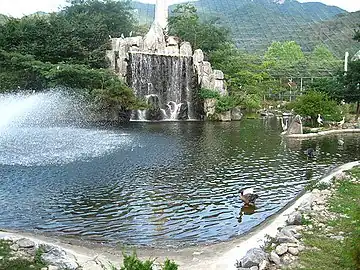 Park view
Park view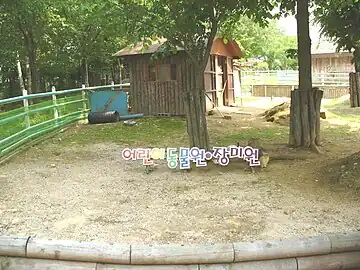 The Entrance to the Children's Zoo
The Entrance to the Children's Zoo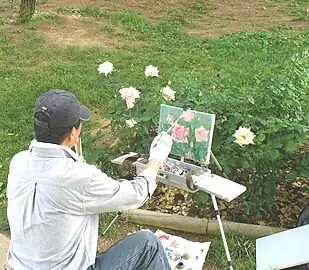 A common scene at the Rose Garden, when the roses are in bloom
A common scene at the Rose Garden, when the roses are in bloom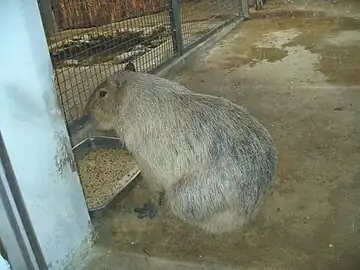 A capybara at the zoo at Seoul Grand Park
A capybara at the zoo at Seoul Grand Park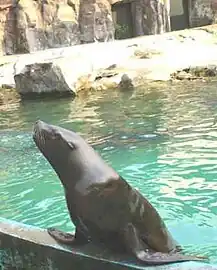 A sea lion at the zoo at Seoul Grand Park
A sea lion at the zoo at Seoul Grand Park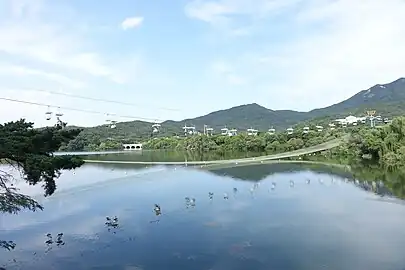 Lake of Seoul Grand Park
Lake of Seoul Grand Park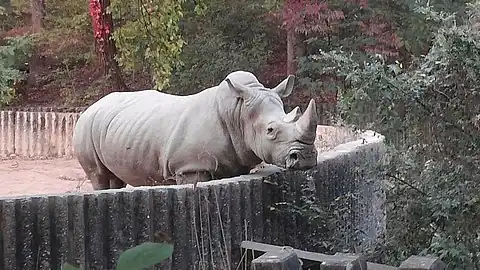 White rhinoceros in Seoul Grand Park
White rhinoceros in Seoul Grand Park
Notes
- "Seoul Zoo > About > Zoo history |Seoul Grand Park". Seoul Grand Park - Zoo history - 서울대공원. Retrieved 3 April 2023.
- "Grand Park > Organization information > About Seoul Grand Park |Seoul Grand Park". About Seoul Grand Park. Retrieved 2 October 2010.
- "Guide > General information > Directions |Seoul Grand Park". Directions - Seoul Grand Park - 서울대공원. Retrieved 3 April 2023.
- "Seoul Zoo > About > About to Seoul Zoo |Seoul Grand Park". Seoul Grand Park - About to Seoul Zoo - 서울대공원. Retrieved 6 April 2023.
- "View Event :: Seoul Grand Park Zoo Tour - Camp Casey". Camp Casey. 18 March 2023. Retrieved 3 April 2023.
- Kim Hyung-eun (1 November 2008). "Cleaning up the zoos". Korea JoongAng Daily. Retrieved 2 October 2010.
- "창경궁박물관昌慶宮博物館의 설립과 변천과정 연구" [Establishment and Transformation of the Changgyeonggung Museum]. Gogung Munhwa (Korean Journal of Palace Museum) (in Korean) (11): 87-129 (43 pages). 2018. doi:10.23008/kjpm.2018..11.004. Retrieved 3 April 2023.
- "한밤중의 창경원 동물 독살사건" [Midnight Changgyeongwon Animal Poisoning Case]. Science Times (in Korean). 25 December 2008. Retrieved 3 April 2023.
- Oh, Chang-young (1993). 韓國動物園八十年史 : 昌慶苑 編 (한국 동물원 팔십년사: 창경원 편) [80th Anniversary of Korea's Zoo: Changgyeong Park] (in Korean). Seoul: Seoul Metropolitan Government. pp. 204–208.
- Oh, Chang-young (1993). 韓國動物園八十年史 : 서울大公園 全國動物園·水族館編 (한국 동물원 팔십년사: 서울대공원 전국 동물원·수족관편) [80th Anniversary of Korea's Zoo: Seoul Grand Park National Zoos and Aquariums] (in Korean). Seoul: Seoul Metropolitan Government. pp. 506–538.
- "과천 서울대공원 탈출 재규어 사살[임정환]" [Escape from Seoul Grand Park in Gwacheon and kill a jaguar [Lim Jeong-hwan]]. MBC TV (in Korean). 28 July 1987. Retrieved 3 April 2023.
- "[The Fountain] How to make Sero, the zebra, happy (KOR)". Korea JoongAng Daily. 29 March 2023. Retrieved 3 April 2023.
- "원숭이가 수박밭에서 음주를?…자유를 꿈꿨던 동물들의 동물원 탈출기" [A monkey drinking in a watermelon field?... Animals who dreamed of freedom escape from the zoo]. Seoul TV (in Korean). 4 December 2020. Retrieved 3 April 2023.
- "'탈출 곰' 아직 못 찾아‥민가로 수색 확대" [Still unable to find 'escaped bear'… Expansion of search to private houses]. MBC TV (in Korean). 7 December 2010. Retrieved 3 April 2023.
- "탈주 곰, 배고팠나?…매점 털어 오랜만에 '포식'" [Runaway bear, are you hungry? Robbing the food stalls, 'predation' after a long time]. MBC TV (in Korean). 13 December 2010. Retrieved 3 April 2023.
- "Zoo helping Malaysian sun bear couple have baby". The Korea Times. 1 August 2014. Retrieved 5 April 2023.
- "Zoo escapee Korean bear recaptured". BBC. 15 December 2010. Retrieved 5 April 2023.
- "말레이 곰 '꼬마' 9일 만에 청계산서에 포획" [Malayan sun bear 'Kkoma' captured in Cheonggye Mountain in 9 days later]. MBC TV (in Korean). 15 December 2010. Retrieved 3 April 2023.
- "Seoul Zoo Reveals Rhino Died from Heart Attack". KBS World. 2 December 2013. Retrieved 3 April 2023.
- "Seoul Zoo halts dolphin show over poaching controversy". Yonhap News Agency. 12 March 2012. Retrieved 3 April 2023.
- "Dolphins returned to the wild". Korea.net. 25 July 2017. Retrieved 3 April 2023.
- "[과학책방] 잘 있어 생선은 고마웠어 外 2권" [[Science Bookstore]Goodbye Thank You for the Fish and 2 volumes]. YTN Science (in Korean). 28 July 2017. Retrieved 3 April 2023.
- "Indo-Pacific bottlenose dolphin to be released after 17 years". Korea JoongAng Daily. 3 August 2022. Retrieved 3 April 2023.
- "Sampal, Chunsam, Boksun and the extraordinary whale facts that Woo Young Woo enlightened us with". Haen.ai. 18 August 2022. Retrieved 3 April 2023.
- "What to do with 'killer tiger'". The Korea Times. 14 February 2014. Retrieved 3 April 2023.
- "Suspect in brutal murder caught". The Korea Times. 21 August 2018. Retrieved 3 April 2023.
- "Suspect nabbed in mutilation murder". The Korea Herald. 21 August 2018. Retrieved 3 April 2023.
- "[단독]우결핵 '쉬쉬'…서울대공원 희귀동물 집단 안락사" [[Exclusive] Bovine tuberculosis 'Shish'... Group euthanasia of rare animals at Seoul Grand Park]. SBS (in Korean). 30 September 2022. Retrieved 3 April 2023.
- 아기공룡둘리 1기💫💚| 2화 대공원소동| 19871007KBS방송 #만화동산#둘리 [Dooly the Little Dinosaur Season 1💫💚| Episode 2 Great Park Disturbance| 19871007KBS Broadcasting #Cartoon Garden#Dooly] (in Korean). 옛날티비 : KBS Archive (published 7 October 1987). 11 May 2022. Retrieved 7 April 2023.